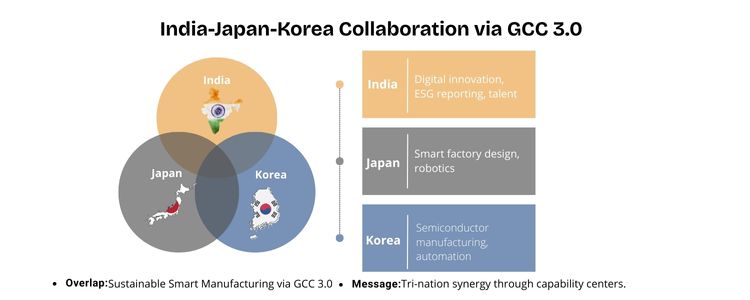
GCCs in India are highly organised, fast-tracked centres of global operations, which are emerging as loci of innovation. The current situation is that R&D spending in India has seen a sharp increase and is likely to accelerate beyond USD 130-140 billion by the year 2030 as opposed to about USD 48 billion in 2018 . Such a rising investment highlights the increased focus on intellectual property (IP) generation in the country. Additionally, the Indian economy will gain beyond measure, with expectations pointing to the fact that R&D and innovation have the potential to contribute up to 2 percent of India’s GDP in the years to come (NITI Aayog). This path will require a shift out of ad hoc, reactive strategies using innovation (commonly called jugaad) to more organised and planned approaches of reverse IP generation. Being one of the most successful GCC Service providers we feel the urge of a cretinous attitude of a cartographer to plough this uneven field and bring the full capacity of innovation to the grave of these facilities.
In this respect, reverse IP generation is not all about duplicating the already-existing technologies. It is an advanced, complex mechanism of careful comprehension, decomposition and reaggregation of the current intellectual property to create new and proprietary solutions. This requires an orderly process, not unlike the cartographer who painstakingly charts unknown territory. This critical direction is the guidance that the COMPASS framework offers, which is explained in seven parts of interconnected quadrants, including Contextual Understanding, Operational Deconstruction, Modular Recombination, Proprietary Synthesis, Architectural Refinement, Scalability, and Strategic Commercialisation. This vision becomes our guide and source of light, bringing global capability centers into a new world in which India is not only a site of IP and service delivery hub but also a world IP machine.
The reactive status quo of jugaad The “COMPASS” framework offers a systematic and extensive way through which GCCs can get out of reactive jugaad and organise the development of proprietary intellectual property. The seven-step model envisages changing these centers to strategic points of innovation, which is a very important step in India making use of the increased R&D investment as well as adding to the world technology scenario.
The first step focuses on the mapping of the reason as to why a certain technology exists. It extends beyond features of products to tear down the whole ecosystem, stakeholders, competitors and the underpinnings of what the users need. Charting of legal and ethical limits is also done diligently in this stage of development so that whatever is developed subsequently is responsible and justifiable. The result is a so-called Contextual Map that lies at the basis of the whole reverse IP strategy.
It is a goal of trying to figure out how it works. This is the systematic disassembly of the hardware and software. It involves a level of component and dependency analysis to provide a complete Bill of Materials (BOM) and a so-called Workflow Blueprint. Such a minute insight into the mechanical workings of the technology is also essential in defining principal modules that could be re-engineered.
In this stage the teams exploit the information gathered during deconstruction by strategically re-engineering the IP. They define what they call composable units and study how these modules may be rearranged or even substituted by better options. This is one of the fundamental steps of coming up with something new, something not merely a replica, and is frequently marked by what is known as a strategic swapping of parts with the intention of improving either performance or reducing the cost.
The new defensible IP is developed here. It means specifying what is to be called the innovation delta, the distinctive value proposition of the new solution, and capturing the definition carefully in a so-called Proprietary IP Dossier. This dossier preserves not only intellectual property but also acts as a strategic plan for further evolution of the intellectual property.
After the synthesis, the given step is devoted to optimising the design of the new IP. It performs, and security audits are made rigorously to make the solution robust, efficient and reliable. The focus here is a move from an operable prototype to a commercial product with clean, scalable architecture that supports long-term evolution.
This measure will guarantee sustainability and economic feasibility of IP. It entails the formulation of an extensive roadmap for expanding the solution to service requirements, market, and user population expansions in the future and planning on cloud-based infrastructure and viable deployment models. Critical considerations are also probed on the economic and environmental sustainability of the solution, hence ensuring a sustainable asset.
The last stage of the framework is focused on the successful translation of the IP into the market. These include elaborate market analysis, what the revenue model will be, and a very captivating go-to-market plan. It is the move that will convert the technological innovation into a lucrative business investment, a feature that will be able to offer practical economic worth to the parent organisation.
Increasingly stepping out of the constraints of the jugaad, the GCCs in India have the opportunity to become contributors of IP within the international system of global IP creation. As one of the major GCC enablers, Inductus GCC will develop partners through this change process. Indian GCCs can tap into untapped innovation potential in ways that are hugely beneficial to the Indian economy and ensure that India builds a footprint as a research and development powerhouse in the future. The maps that all of us are building now will perform to map the technology landscape of tomorrow.
It is shifting away from ad hoc and reactive ways of fixing things (jugaad) to repeatable, systematic innovation systems that can create large-scale, patentable IP and create enterprise value over time. Popular paradigms are Banking and financial services (BFSI), E-commerce and retail, Pharma and Life Sciences, Automotive & Mobility, ESG and climate tech. It is through domain and digital convergence that these sectors are generating new value. The important innovation KPIs are Structured innovation will be fundamental to generating IP that will belong to the world in the form of India-for-world, given India is turning into a deep-tech talent pool and GCCs are developing into digital competency hubs. This does not only place Indian GCCs as support engines but also as strategic backbones of global product leader makers. Aditi, with a strong background in forensic science and biotechnology, brings an innovative scientific perspective to her work. Her expertise spans research, analytics, and strategic advisory in consulting and GCC environments. She has published numerous research papers and articles. A versatile writer in both technical and creative domains, Aditi excels at translating complex subjects into compelling insights. Which she aligns seamlessly with consulting, advisory domain, and GCC operations. Her ability to bridge science, business, and storytelling positions her as a strategic thinker who can drive data-informed decision-making.
Reverse IP creation in GCCs: The COMPASS Model
The COMPASS Framework: An Insider's Guide to Inverting IP Creation in GCCs
1. Contextual Understanding
2. Operational Deconstruction

3. Modular Recombination
4. Proprietary Synthesis
5. Architectural Refinement
6. Sustainability and Scalability
7. Strategic Commercialisation
Quadrant
Focus
Key Activities
Deliverable
CONTEXTUAL
Understanding the “Why”
Ecosystem Mapping, Reverse User Empathy, Legal Boundary Mapping
Contextual Map
OPERATIONAL
Understanding the “How”
Systematic Teardown, Component Analysis, Data Flow Tracing
Operational Blueprint
MODULAR
Strategic Re-engineering
Identify Composable Units, Strategic Swapping, Alternative Analysis
Recombination Matrix
PROPRIETARY
Creating Defensible IP
Define Innovation Delta, Comprehensive Documentation, and Patent Strategy.
Proprietary IP Dossier
ARCHITECTURAL
Optimising the Design
Performance & Security Audits, Clean Code Architecture, Design Refinement
Refined Architecture
SCALABILITY
Ensuring Longevity
Cloud Strategy, Microservices Planning, Resource Efficiency Assessment
Scalability Blueprint
STRATEGIC
Business & Market Plan
Market Analysis, Revenue Model Definition, Go-to-Market Plan
Commercialisation Plan
Conclusion
frequently asked questions (FAQs)

Aditi
Hey, like this? Why not share it with a buddy?
Related Posts
Recent Blog / Post
- Agile Methodologies for GCCs: A Blueprint for Success October 6, 2025
- The Legal and Compliance Checklist for a New GCC Setup October 4, 2025
- The Rise of Niche GCCs: A Focus on Specialised Capabilities October 4, 2025
- The Impact of Regulatory Changes on GCC Operations October 4, 2025
- Cybersecurity for GCCs: A Proactive Approach to Data Protection September 30, 2025
- Beyond Cost: Measuring the True ROI of Your GCC Investment September 29, 2025
- The Future of GCCs in the Retail Sector: A Strategic Playbook September 29, 2025
- David vs Goliath: Mid-Sized GCCs Quietly Outperform the Big Brands September 29, 2025
- Infineon’s Big Bet on India: Inside Its First GCC in GIFT City September 29, 2025
- From Campuses to Capability Centres: How Indian Universities Power the Global GCC Ecosystem September 29, 2025
- Retail Meets Digital: Costco’s GCC in Hyderabad Marks a Global Shift September 29, 2025
- The Silent Crisis: Why Many GCCs Plateau After 3 Years and How to Avoid It September 24, 2025
- Germany’s New Skilled Immigration Act and Its Ripple Effect on the GCC Talent Model September 24, 2025
- From Tokyo to Hyderabad: The Future of GCCs for Japanese Conglomerates September 23, 2025
- GCCs as AI Acceleration Hubs: Collaborating with US and Nordic Tech Majors September 19, 2025
















